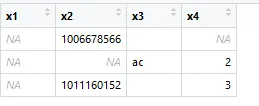我有一个大文件需要在R中导入。为此,我使用了fread。但是,fread将数值字段中的空格识别为NA,但未将字符和integer64字段中的空格识别为NA。
fread将字符字段中的空格识别为空单元格,将integer64字段中的空格识别为0。
当我使用read.table导入相同数据时,它将所有空格识别为NA。
请查看以下可重现示例:
library(data.table)
x1 <- c("","","")
x2 <- c("1006678566","","1011160152")
x3 <- c("","ac","")
x4 <- c("","2","3")
df <- cbind.data.frame(x1,x2,x3,x4)
write.csv(df,"tr.csv")
tr1 <- fread("tr.csv", header=T, fill = T,
sep= ",", na.strings = c("",NA), data.table = F,
stringsAsFactors = FALSE)
tr2 <- read.table("tr.csv", fill = TRUE, header=T,
sep= ",", na.strings = c(""," ", NA),
stringsAsFactors = FALSE)
详细输出:
Input contains no \n. Taking this to be a filename to open
[01] Check arguments
Using 4 threads (omp_get_max_threads()=4, nth=4)
NAstrings = [<<>>, <<NA>>]
None of the NAstrings look like numbers.
show progress = 1
0/1 column will be read as integer
[02] Opening the file
Opening file tr.csv
File opened, size = 409 bytes.
Memory mapped ok
[03] Detect and skip BOM
[04] Arrange mmap to be \0 terminated
\n has been found in the input and different lines can end with different line endings (e.g. mixed \n and \r\n in one file). This is common and ideal.
[05] Skipping initial rows if needed
Positioned on line 1 starting: <<"","x1","x2","x3","x4","x5","x>>
[06] Detect separator, quoting rule, and ncolumns
Using supplied sep ','
sep=',' with 7 fields using quote rule 0
Detected 7 columns on line 1. This line is either column names or first data row. Line starts as: <<"","x1","x2","x3","x4","x5","x>>
Quote rule picked = 0
fill=true and the most number of columns found is 7
[07] Detect column types, good nrow estimate and whether first row is column names
'header' changed by user from 'auto' to true
Number of sampling jump points = 1 because (407 bytes from row 1 to eof) / (2 * 407 jump0size) == 0
Type codes (jump 000) : 56A255A Quote rule 0
All rows were sampled since file is small so we know nrow=16 exactly
[08] Assign column names
[09] Apply user overrides on column types
After 0 type and 0 drop user overrides : 56A255A
[10] Allocate memory for the datatable
Allocating 7 column slots (7 - 0 dropped) with 16 rows
[11] Read the data
jumps=[0..1), chunk_size=1048576, total_size=373
Read 16 rows x 7 columns from 409 bytes file in 00:00.042 wall clock time
[12] Finalizing the datatable
Type counts:
1 : bool8 '2'
3 : int32 '5'
1 : int64 '6'
2 : string 'A'
=============================
0.009s ( 22%) Memory map 0.000GB file
0.029s ( 68%) sep=',' ncol=7 and header detection
0.002s ( 5%) Column type detection using 16 sample rows
0.001s ( 2%) Allocation of 16 rows x 7 cols (0.000GB) of which 16 (100%) rows used
0.001s ( 2%) Reading 1 chunks (0 swept) of 1.000MB (each chunk 16 rows) using 1 threads
+ 0.000s ( 0%) Parse to row-major thread buffers (grown 0 times)
+ 0.000s ( 0%) Transpose
+ 0.001s ( 2%) Waiting
0.000s ( 0%) Rereading 0 columns due to out-of-sample type exceptions
0.042s Total
请帮我解决这个问题。
谢谢!
